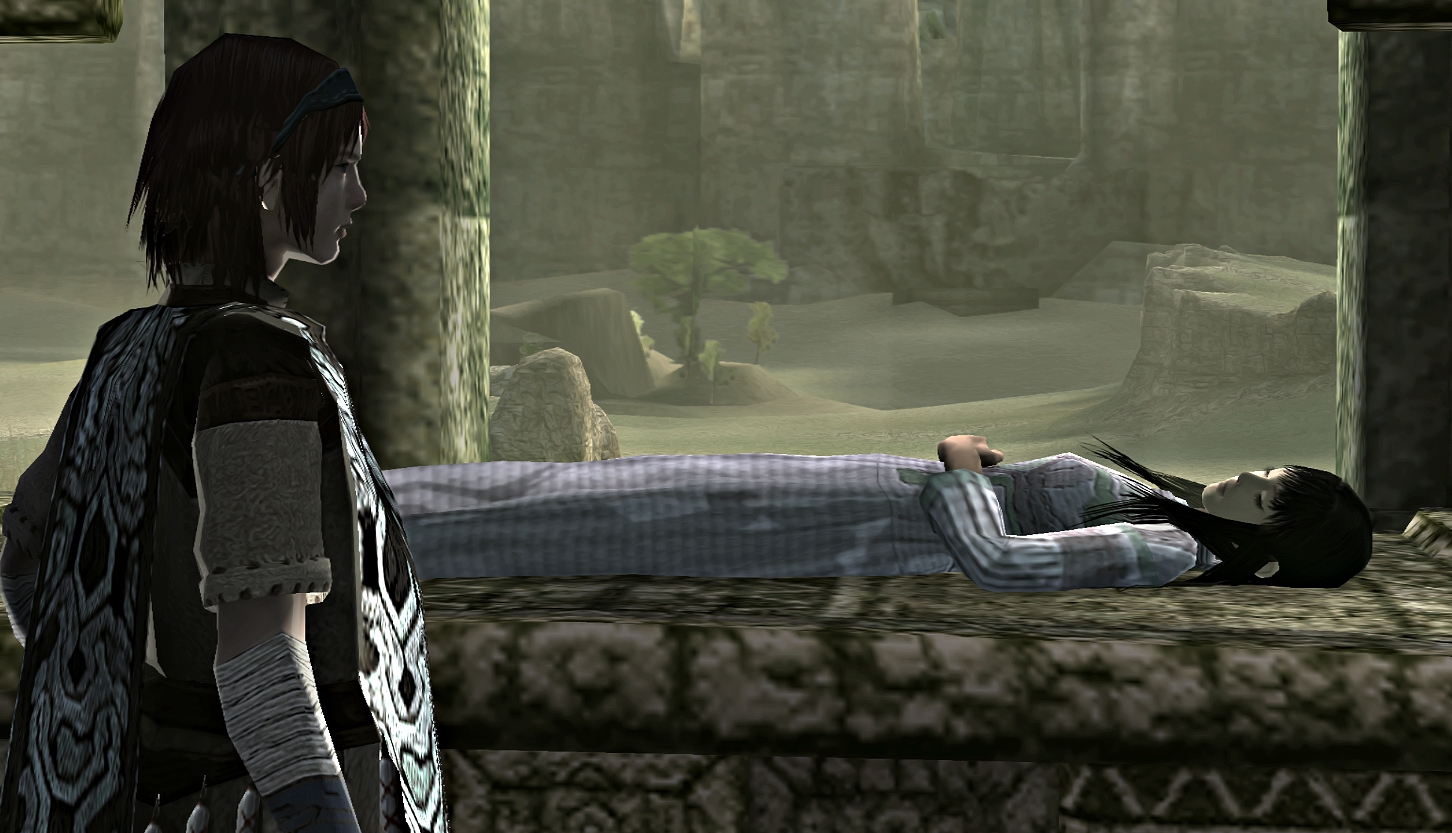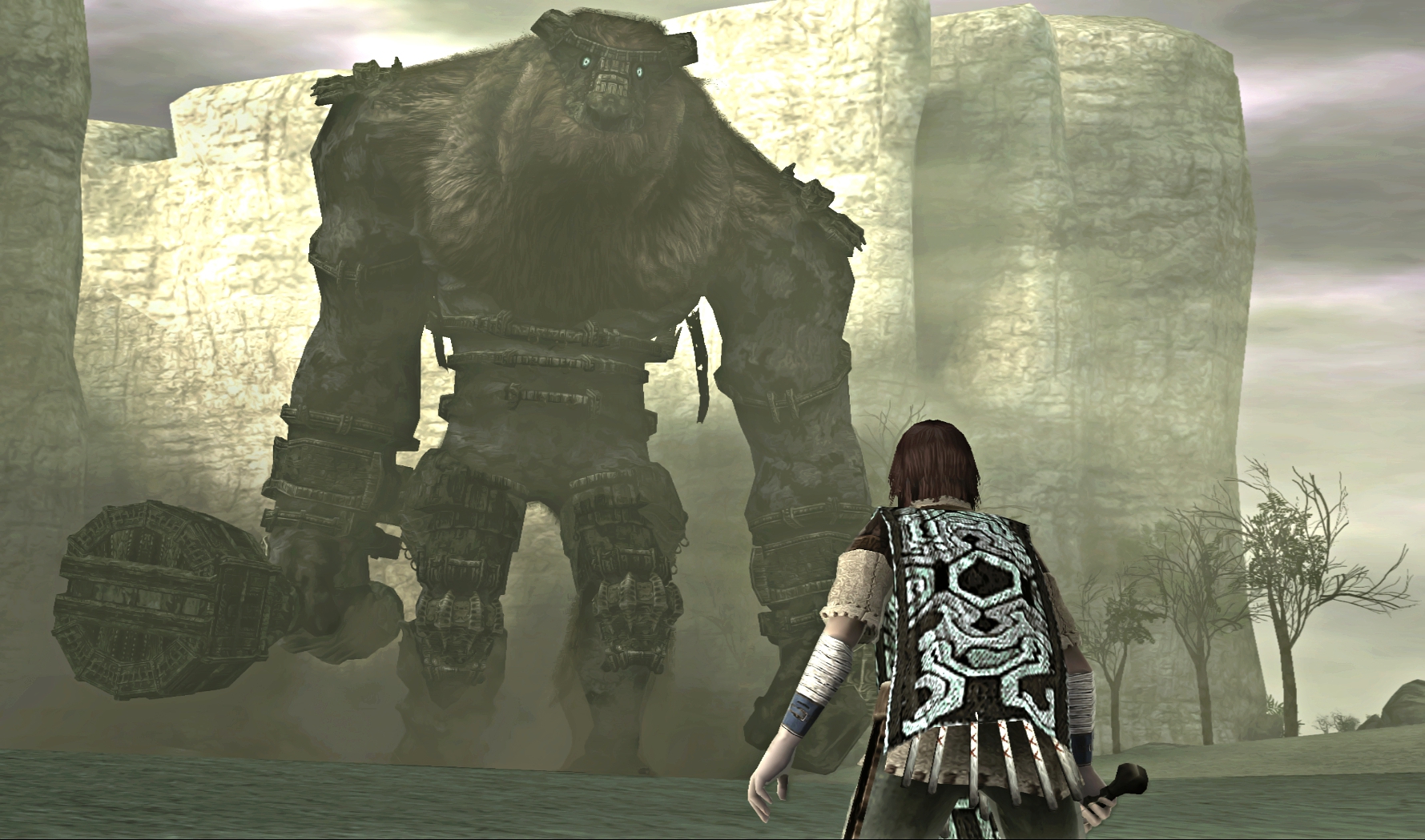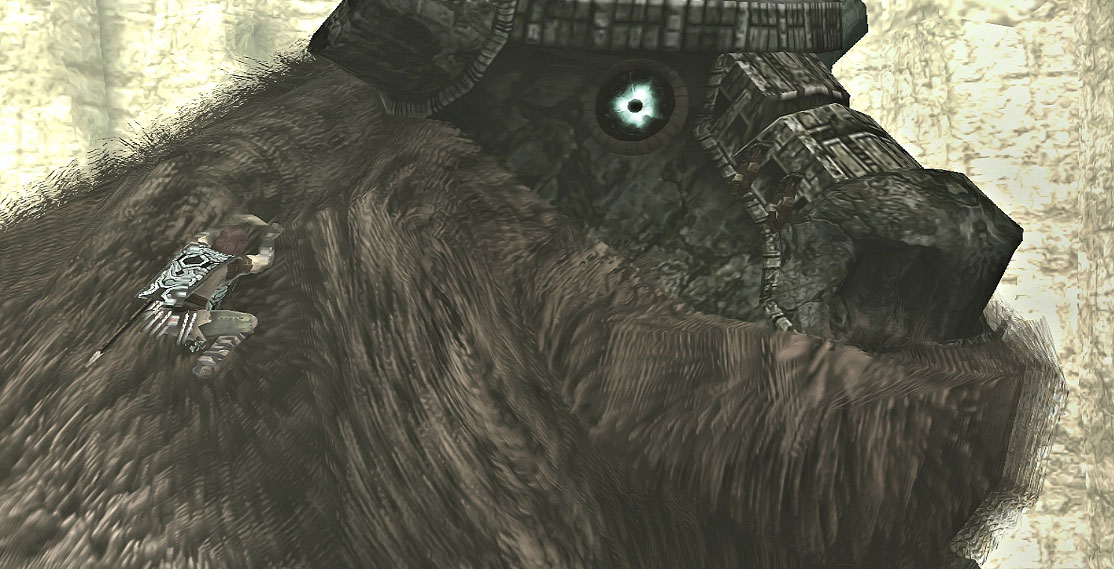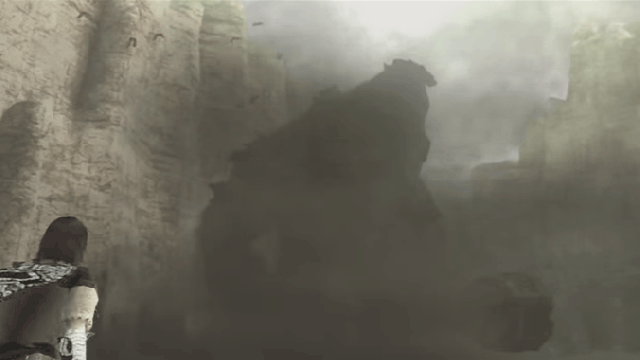The opening cinematic ends as the camera transitions into live gameplay, and I’m given control for the first time. Moving Wander around is a joy, both in execution and for the fact that there’s no particular rush or threat as I prepare myself for this world and its as-yet unseen battles. The shrine is empty, save for Mono lying still, and my horse Agro, quietly exploring nearby while I come to grips with the controls.
Nick Suttner is a former games writer and current indie games champion at PlayStation, who has gone and written a book on Shadow of the Colossus. This is an excerpt from the book’s chapter “Raise thy sword by the light”.
Wander’s gait is more mature than Ico’s, the earned confidence of an adventurer rather than that of a resilient child. His jumps are fearless lunges forward that can cover a lot of ground. If his sword is unsheathed, he’ll run with it ninja-like, pointing it down and back along his side. And many of his basic movements are contextual — he’ll leap from a running horse, or simply dismount with a step down from a stilled one. Agro is a star in her own right — a living, breathing companion and partner in crime for Wander, not simply a vehicle for speed or safety. And when I’m not riding her, she’ll wander off on her own, or rein up dramatically alongside me without prompting, or stay close when staying close is called for. She’s unpredictable, as animals are, but a fierce friend and really my only one in this world.

As we leave the confines of the shrine, the true breadth of this place — the Forbidden Lands, as they’re known — becomes evident, and with it a mounting sense of adventure. It’s breathtaking. Rolling wind-swept hills and crags flow off into the distance ahead of me, overcast skies above burning with sunlight just behind the clouds. The camera stays low, following behind and keeping Wander off-center, maintaining focus on the landscape. Even while casually exploring, there’s a sense of cinematography to the framing, some distant director playing up the drama of each shot while maintaining a visual balance.
An old companion returns in the howling wind from Ico, making the Forbidden Lands feel just a bit more lonely and desolate. While I can charge off in any direction and explore for hours, I won’t be able to progress without finding and defeating the first colossus. Dormin has given the first hint — “Raise thy sword by the light” — and holding the Circle button does just that, reflecting the sunlight off of my sword to create a simple 3D radar that focuses from a wide net down to a tight beam as I point towards the location of my next foe. This works on foot or while mounted, as long as I have access to sunlight (which adds a challenge in some shaded spots later on). It’s an elegant replacement for a traditional waypoint marker that avoids the visual busyness of so many modern games.
The first colossus lies directly south, a relatively quick journey from the shrine straight across the plains to the cliff walls in the distance. Along the way, I pass a small oasis along the edge of a hill, a verdant outcropping surrounding a large tree. It’s a bit unfair since I’ve played the game many times, but I know that the alluring fruit hanging from the highest branches can be retrieved with a single shot from my as-yet-unrevealed bow. I equip it with a quick flick of the D-pad, and hold down the Square button to nock an arrow and aim. The bow feels good, responsive, and once I’ve shot down a piece of fruit I can pick it up and consume it, slightly extending my health bar. This discovery may not happen during your first playthrough if you’re not curious enough to stop or figure out the bow, but finding these fruits is one of the very few activities outside of fighting the colossi.
Back on track, l soon hit a shadowed basin below a cliff (roughly where the light directed me to), where a short cutscene kicks in. The camera tilts up to the top of the cliffs, as panpipes chirp a mysterious, searching little tune that tells me I’m in the right place. To scale the cliff, I’m given a crash course on how to climb mossy vines, roll under obstacles, pull myself up ledges, and jump from one handhold to another. It’s a smart, concise introduction to the same tools I’ll need to scale and fell my first foe (and subsequent others), if a bit overt with its messaging. Whereas Ico didn’t put a single instruction on screen in its entire playtime, Shadow spells out all the basics up front through a short series of tutorial messages. It’s certainly a more mechanically complex game than Ico, but it’s a bit of a shame that the first few minutes lean more on non-diegetic instruction, when the atmosphere and storytelling are otherwise so immersive. This section also serves to separate me from Agro for the first time, which feels discomforting even in these early moments.

As I crest the top of the cliff, next to a thin cluster of trees, rocks, and bushes, from somewhere to my right comes an echoing bellow and a series of earth-shaking stomps. Massive, hoofed feet fill my vision as they tromp by, attached to legs like mossy oaks, and a huge armoured hand swings low to the ground. The behemoth walks past me, trees rattling and a black cloud of dust kicking up in his wake, my controller rumbling with each monstrous step. I’m given back control of Wander before I’ve had time to fully process the scene, and all lonely comforts are forgotten. I focus on my new foe, birds circling above him as he patrols this canyon, wielding a massive club with gorilla arms. There’s so much to take in — there have been no practice runs, no smaller enemies to cut my teeth on. I’m alone against massive odds. The creature feels like an ancient extension of this wild place, disturbed by my presence. The haunting colossus design has become an evocative touchstone of my mind’s eye — this first colossus, the box art cover star who forever adorns my Mac’s desktop background in a piece of fan art whose origins I’ve long forgotten. The colossus is terrifyingly top-heavy, a broad-shouldered brute with piercing blue eyes shining out from a face constructed of symmetric stone and a shaggy, shoulder-spanning mane of mossy fur. The colossi often look like long-abandoned temples come to life, elements of their bodies or armour seemingly designed by some great mason. “I avoided designs that made it obvious what the motive was,” Ueda told OPM in 2005, “so I combined various things, like the front of a car or the surface of a building. Normally, things like that aren’t used for monster design. By doing so, I thought that the colossi would have peculiarities, yet seem realistic at the same time.”
Holding the L1 button will focus the camera on a colossus for as long as the button is held, immediately useful in taking in my foe while keeping my distance as I plot my attack. There’s not much space in this clearing, and nowhere else to go — I could climb all the way back down, perhaps find some comfort in seeing Agro again, but there’s no other way to progress. In this way, the game puts my back against the wall while at the same time placing the impetus on me to take action and make the first strike. The colossus patrols nearby, but Wander must disturb its path to begin the battle. While most traditional video game boss battles lock the player in a small arena with an enemy who immediately attacks, Shadow casts the player as the aggressor instead, a distinction with ever-growing importance throughout this tale. It’s the beginning of many role reversals that become more evident as the game progresses — but like many things in Shadow, the theme starts more subtly.
I wish that I could remember the feeling of playing out this battle for the first time, but it’s just out of reach. My first hands-on exposure to Shadow was in 2005 on the blaring show floor of E3, the annual industry showroom hullabaloo. I was there to cover it for an enthusiast gaming blog (G-Pinions.com) that I ran with my friend Tom Mc Shea, and my primary takeaway was that E3 was simply the worst environment in which to experience something so nuanced, especially considering how excited I was for the game. Months later, Tom and I would crack open a final copy of Shadow in the more appropriate quiet of my apartment, and truly experience what it had to offer.
During that same period, I worked as an assistant manager under my friend Greg at an EB Games store in Chicago, where we took immense pride in championing all sorts of weird and unique games to our customers — through our infectious excitement, our store garnered the most pre-orders of Shadow in our district. Despite the hellish stereotype of working at a video game store, EB felt like the front lines of the gaming industry. Later, while reviewing games professionally, I would put a piece of criticism or a recommendation out into the world, and eventually it would garner comments, maybe influence a few purchasing decisions… but in those years behind the counter, people would ask me to recommend a new game, and I could walk them over to Shadow, bursting with superlatives, and place a copy in their hand. The best feeling in the world would come about a week later when they’d come in raving about it and ask me for my next recommendation.
While I was doing my best to champion Shadow online and in my store, other fans were taking further initiative — to bestow names upon the colossi, for which no official names are ever given (in-game or anywhere else). It’s not entirely clear where these names originated — many cite a 2004 thread on the PlayStation forums in which user Thantanos mentions a “friend in Japan” who read them in an issue of Dengeki PlayStation Magazine, but by all accounts it appears that said issue never existed. Nevertheless, the intel apparently provided by this legendary Japanese friend has granted the colossi the closest thing to official names that they have. Complicating things further, Greg Off of Off-Base Productions — who wrote the original strategy guide for Shadow — explained to me that in the development build that he played while writing the guide, the game referred to the colossi by a different set of names (since forgotten), which he was later asked to remove from the final guide. It’s likely that those were similar to what the development team referred to them by during production — in the case of the first colossus, “the Minotaur.” I find his fan-bestowed name — Valus — much more personable, so let’s stick with that. I’m also going to go with “him” for my colossus pronoun of choice, as the more anthropomorphic creatures read as male, and “him” feels more reverent than “it.”

The battle begins by noticing Valus’s furry achilles (a well-known weak spot, mythologically), which I can grab onto once I’ve evaded his earth-rattling stomps. Climbing a bit higher and unsheathing my sword, a glowing bluish-white sigil appears beneath the creature’s fur. By holding the Square button, I charge up a one-handed stab of my sword while clinging on to Valus’s ankle with the other hand, and letting go at just the right moment drives the weapon deep into Valus’s flesh. He kneels briefly in pain from the impact, giving me a moment and a handhold within reach to scurry up onto the balcony-like structure built into his back. This also triggers a change in music, an appropriately epic blast of horns and pounding drums that mounts in intensity as I climb higher. The music throughout Shadow feels as if it’s being orchestrated live, mirroring the drama, curiosity, or anguish of each moment.
I climb high enough to be able to run the rest of the way up his back and onto his broad neck, though stumbling and tumbling over in an attempt to stay upright while he shakes in protest and rears his massive head. It’s at this point that players will realise that despite the relative precision of the jumping and grabbing — all the while discovering which parts of a colossus can be gripped — that Shadow is very much a game about trying to perform those actions under extreme duress, as if someone was slapping at the controller while you try to hang on for dear life. Shadow‘s mechanical use of that verb — holding on — is also one of its most effective analogs for the real-life experience of playing the game. Bennett Foddy, an assistant professor of game design at NYU and the creator of the 2008 ragdoll runner QWOP, spoke to me about this link. “Generally in video games there is a very weak correspondence between the type of action you perform in the real world, on your controller, and the action that subsequently occurs in the game world. In Super Mario Bros. and every game that followed it, I press a button down and that makes my character jump into the air, even though compressing the spring under a button is not really anything like jumping into the air.” Foddy notes that the gripping actions taken in Shadow, however, directly translate to how the player is manipulating the controller. As the player holds down the grip button for longer periods of time, it directly corresponds to Wander’s fatigue, measured on-screen, even aching after longer sessions. “I feel more embodied in the character of Wander than I do in almost any other third-person game. It might be the best and deepest use of correspondence between controls and character actions that we’ve ever seen in a game.”
Another central mechanical element that coheres the challenge, the colossi, the controls — and really the entirety of the gameplay — is the concept and measurement of Wander’s stamina. As I grip and hold onto anything in the game — or hold my bow drawn, or swim underwater, or charge up a sword strike — a pink circle appears in the lower-right corner of the screen, and decreases as I continue the action. If I let go and return to a default state, the bar will slowly refill — in short, I can’t hold on to anything for too long. This introduces a constant stream of strategic considerations when ascending and hanging onto foes, a lesson Valus teaches early on. Even once I’ve managed to get up to his back, I must seize the moment before I’m knocked off entirely. I need to get to the top of his head, and every so often it becomes necessary to let go of his fur and regain my grip while balancing awkwardly, like surfing a subway train without a handhold. I get my feet under me long enough to forge forward onto his head, where I find another glowing sigil. Valus roars desperately as I drive Wander’s sword into this vulnerable spot, each time producing a thick arterial spray of inky black blood or some arcane lifeforce. His previously still blue eyes flash orange with… anger? Confusion? Fear?
Valus has a health bar of his own at the top of the screen, and the moment my final stab empties it a cutscene kicks in. Valus collapses bodily, falling forward limp upon the ground, a destructive collision of one big dead stone into another. At the same time, a mournful tune swells, a choir paying their respects to this difficult moment. This is no celebratory music, no triumphant Final Fantasy post-battle fanfare (a Pavlovian reward for victory in that series). There’s no winning message, no experience points tallied, no positive reinforcement or typical game-like closure of any kind. The only indication that it’s over is that Wander is still alive and the colossus is not. The music fades to careful strings as control is given back to me, while Valus’s body is enveloped by black fog. Blue-black tendrils shoot out from the fog, hovering momentarily like undecided cobras before piercing Wander’s body with their full force, a violent crunch juxtaposed with the serenity of the music. No matter how far I run in that moment, they always find me, an inescapable, futile dance. Wander collapses, his own body taking on some of the blackness, and the scene fades to white — and then into imagery of moving through a dark tunnel towards a bright light, swirling voices (maybe Mono’s?) echoing from somewhere in the ether.
Valus is Ueda’s favourite colossus, a critically important introduction to the true meat of the game — one that took significant trial-and-error to get just right. It feels unfair until the moment it doesn’t, all the accomplishment of fighting a “boss” without the typical buildup. But at the same time I feel a bit conflicted by the violence of my actions and the reward of a solemn, uncelebrated death. It’s clear even in this first victory that what I’m doing is wrong on some level, though I’ve journeyed too far to not continue at least a bit further down this road, into the depths of Dormin’s deal.
After being given the option to save my progress, I’m taken back to the shrine. A shadowy figure stands silently over Wander’s body, watching. How did I get back here? Was this wraith involved? Wander wakes, groggily, and the figure is gone. He immediately moves to check on Mono, who lies still as ever, though undisturbed. Somewhere, an organ swells, as one of the beastly statues nearby glows from within, a turquoise light piercing its cracks, before the whole thing shatters into rubble.
Shadow of the Colossus by Nick Suttner is published by Boss Fight Books. It will be released on December 15. You can grab it here.

Comments
8 responses to “The First Shadow Of The Colossus Fight Is A Masterpiece”
I really have to get around to playing this.
Seeing the first colossus, and a few of the later ones, are the only real ‘oh shit’ gaming moments that have stuck around in my mind.
Still seriously one of the greatest games of all time. Wasn’t QUITE as absolutely perfect as ICO (I have endless admiration for how ICO managed to completely do away with all “gamey” aspects like interface altogether, plus Yorda will have my love forever), but vastly more epic and weighty in scope. If I made a top 10 games of all time list, this game would be on it (ICO would be on it just a bit higher).
Agree about ICO. What an unforgettable experience.
What are your thoughts on The Last Guardian?
ICO is on my backlog list :/ I played shadow, and it’s one of my all time favs – but I hated having to kill the colossi, I really wanted an option not to (even though that was really the whole point). Man it still gives me the feels just thinking about it.
So, now that we’re getting PS2 games for the PS4, wouldn’t it be rad if we could take all of those HD remasters we’ve bought over the life of the PS3 (Metal Gear, Silent Hill, Zone of Enders, SotC & Ico, God of War, etc) and just pop them in the PS4 (or redownload them) and have them work? Wouldn’t that be nice.
Please? Sony?
Seconded.
Funny, I was thought about that yesterday while I was watching a Digital Foundry comparison of GTAIII and GTA: Vice City on PS2 and PS4. It would be counterintuitive to bring over PS2 games of to the PS4 if there are PS3 HD remasters available, unless Sony re-remasters those games to PS4 like what they did with FFX.
If I ever decide to get a tattoo for a video game. It’s gonna be SotC. I regret not playing it more. And I wish there was more info our about it.